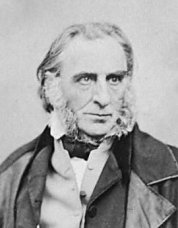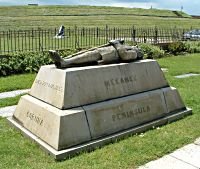
Transcribed from the "The Annals of Portsmouth" by WH Saunders (Pub. 1880)
SPACE will not permit in these pages of such a lengthened biography of this great fighting chief as to do justice to his memory. Few have passed through a career of such strange vicissitudes as Sir Charles Napier, the conqueror of Scinde. Brave to a fault, given in his early days to danger for the sheer love of it, daring to rashness, indomitable in perseverance, rapid in execution, and as ready to fight with his tongue and his pen, as with his sword. Like Nelson, he was spare and fragile, of a strangely wild and wierd appearance, and resembling too that great sea captain in his restless energy, and uncontrollable longing for action. We see him at one time fighting as a commissioned officer, at another as a volunteer.

Now he is governor of a colony, again a navigator, then a diplomatist. When our Indian Empire was, by a series of disasters, shaken to its foundation, and it was necessary that immediate steps should be taken for its security, the Iron Duke said-" Napier, if you don't go, I must." He went, and his splendid victories of Ferozepore, Aliwal, and Sobraon, bore testimony to his generalship, and the powers of his soldiers.
Charles James Napier was the son of Colonel George Napier, and was born at Whitehall, on the 10th of August, 1782. He was a delicate child, and brought up accordingly ; removed while young to Ireland, he there received his education, at the hands of his father, and before he was twelve years old lie received, on the 31st of January, 1799, his commission as Ensign in the 22nd Regt. of Foot ; and on the 8th of May following, he was gazetted as Lieutenant. His regiment remained in Ireland for some years, where he was made Aide-de-Camp to Sir James Duff, when he was employed in quelling the insurrection occasioned by Emmet's plot.
At the end of 1805 he obtained his company, and exchanged into the 50th. Receiving his majority in 1806, he commanded the regiment during the terrible retreat on Corunna under Sir John Moore, where that gallant leader fell. Major Napier was wounded in five places in that fatal battle, and was taken prisoner. Sir W. Napier, in his " English Battles and Sieges in the Peninsula," says-" Encompassed by enemies, and denied quarters, he received five wounds, but he still fought and struggled for life, until a French drummer, with a generous heat and indignation, forcibly rescued him from his barbarous assailants."
The same authority says-" Advancing over broken ground, armed with a musket, he called on his men to follow him, three or four who obeyed him fell in the attempt, the fourth was wounded, and the last hung back. Napier was in the act of helping a wounded man when he was shot by a musket ball which broke one of his shank bones. Throwing down his musket, he was hobbling along leaning on his sword, when a Frenchman ran his bayonet into his back. Major Napier turned round and disarmed his assailant, now supported by several others, whom the Major gallantly faced, until he was knocked down senseless by the butt end of a musket, and was about to be dispatched outright, when the benevolent drummer interfered and dragged him out of the melee."
Sir William Napier mentions five wounds, and the same number is given in " Hart's Army List," to wit, "leg broken by musket shot, sabre cut on the head, in the back by a bayonet, ribs broken by a cannon shot, and several severe contusions." Soult dismissed him on his recovery on parole.
In 1811, Napier was again fighting fiercely at Coa, in the Peninsula, where he had two horses shot under him. At Busaco he was shot in the face, having his jaw broken and the eye injured ; and he actually rode to Lisbon, a distance of over a hundred miles, where the ball was extracted from behind the ear. He was again at Fuentes d'onore, and was present at the second seige of Badajoz, and at the sanguinary battle of Albuera, where Soult was defeated.
After a brief sojourn in England, Napier was again fighting, this time at sea, off the Chesapeake, capturing American vessels. Back again to England, Napier just missed the great catastrophe of Waterloo ; he arrived three days after the battle and took part in the storming of the ramparts of Cambray, and the occupation of Paris. During the period of military inactivity which followed, Napier was governor of Cephalonia.
After a short command of the military districts of the north of England, he took command of the Bombay army, where he gradually arranged his plans for the campaign against the treacherous Ameers of Scinde. Their defeat at Meanee, and the battle of Emaum Ghur, completely disheartening the Belochees, and the great fortresses of Hydrabad and Omercote were taken. Napier was now made governor of Scinde. The Sikh war followed, in which he reaped if possible still greater laurels.
Sir Charles in 1849 again started for Bombay to retrieve the disasters of the last Sikh war, but the enemy had been finally routed before his arrival. After two years in India he returned to England and lived in great seclusion. He attended the funeral of his illustrious comrade, Wellington, in St. Paul's Cathedral ; it was noticed that he looked ill and wan, and walked with difficulty. Seventy one years, with a body covered with wounds, and with fifty four years of his life spent in untiring energy in his profession, he died full of years and honours at Oaklands, near Portsmouth, on the 29th of August, 1853.
In consequence of the General dying on half-pay, it was contrary to the regulations of the service to give him a full military funeral, but it was in all respects the same, saving only that the troops attended without arms, nor were there any salutes of honour fired ; but what was wanting in show was more than made up in feeling. The following was the order of the procession, which entering Landport Gate passed down to the Garrison Chapel, solemn and silent, broken only by the mournful throbbing of the muffled bells of St. Thomas's Church.
Both sides of the streets the entire distance were lined the 79th and 42nd Highlanders, the 35th, and 2nd Battalion Rifle Brigade, Royal Artillery, Royal Marine Artillery, and Royal Marines.
The respective regiments closed in the line of procession as the body passed. On the lid of the coffin was the General's hat and plume, and two swords, one of these his sword of service, the guard of which was torn up and bent backwards towards the blade from the hilt ; this was the work of a gingal ball at Hydrabad. The second was a Sabre d'honneur, a richly mounted weapon, presented to the General by Lord Ellenborough when Governor General of India. The funeral service was feelingly read, the officers of every regiment in the garrison and the Prussian frigates, as well as the seamen of the Royal Yacht, forming a circle round the vault.
At its conclusion Sir W. Napier, standing by the side of the grave, said -" Soldiers! There lies one of the best of men-the best soldier-the best christian that ever lived! He served you faithfully, and you served him faithfully. God is just." He could proceed no further ; he evidently intended to say more, but was unable to command his words. And so his body was buried in peace ; and now arises the reflection, how it was that after this life of active service for his country Napier's body was not allowed to rest by the side of the two great Captains of the age, Nelson and Wellington, in England's Pantheon ?

Napier was a military reformer, and was, as before said, as ready with his tongue and pen as with his sword, therefore he had enemies ; but he sleeps in the little plot of ground alongside the Garrison Church, in companionship fitting for a warrior, because the spot is literally crammed with the dust of heroes.
A plain stone monument with a recumbent figure of the General upon it, pressing his cross hilted sword to his breast and with the names of his victories unpretendingly sculptured ; this, and a stall in the Church itself, are the only mementos of General Sir Charles James Napier, the conqueror of Scinde ; and Wolfe's splendid lines penned on the death of Sir John Moore, his old comrade, tell with thrilling effect as we dwell upon his history.
" Lightly they'll talk of the spirit that's gone,
And o'er his cold ashes upbraid him ;
But little he'll reek, if they let him sleep on,
In the grave where a Briton has laid him."
WH Saunders
POSTSCRIPT
Sir Charles James Napier was buried in a vault a few feet outside the Western end of the Garrison Church. In 1866, just 13 years later, the Garrison Church entered a period of restoration directed by the noted Architect G.E. Street. One of his decisions was to reinstate a 20ft bay of the church which had been dismantled many years earlier after falling into disrepair. This had the effect of extending the church 20ft westwards which in turn meant that Napier's vault had to be incorporated within the body of the church. The tombstone (pictured above) was too large to be accommodated within the building and so was moved to it's current location, a few feet outside the new western end of the church. Thus Napier's tomb is over 20ft from the tombstone. A plaque was set into the floor of the Nave to indicate the position of the vault but this was removed after the church was bombed in 1941 and is currently on display in the chancel.
Tim Backhouse, Trevor Gale